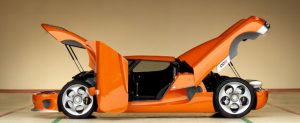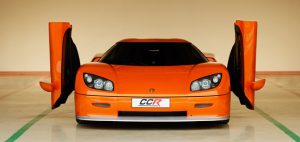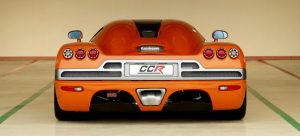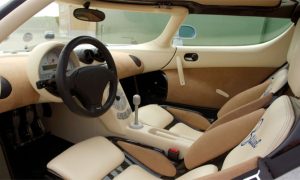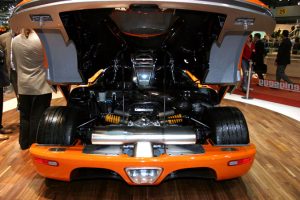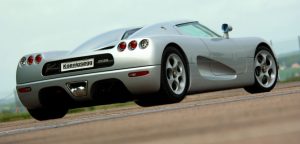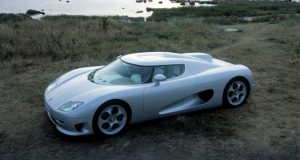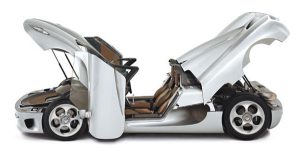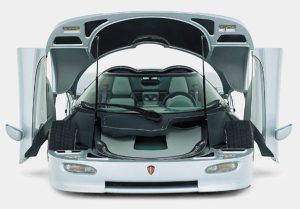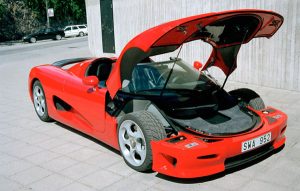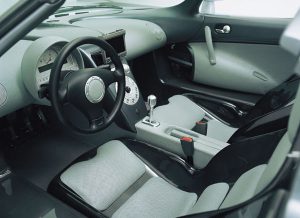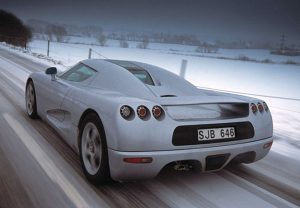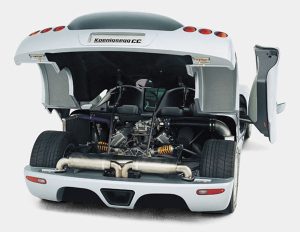
Koenigsegg manufactures exclusive super sportscars for a select elite of enthusiasts. Spaceage materials and uncompromizing quality both in finish and function make these cars among the very best in the automotive history. They reach higher top speeds and are more powerful than any other series-produced car today.
Two models are currently in production; the CC8S, which now holds the Guinness World Record for the most powerful streetcar, and the magnificent new 806 hp CCR. Both Koenigsegg models are built to excel on the road or racetrack, yet are still highly comfortable for long distance travelling.
Machined For Speed. Koenigsegg’s design seeks to give an interpretation of strength and flowing motion. The body of a Koenigsegg is formed for one ultimate purpose; speed. Its beauty is the beauty of speed itself. The surfaces are shaped to perfectly aerodynamic, an appearance that does not deceive. All aspects of this machine serve its one fundamental objective.
Both the body and chassis of a Koenigsegg are made of extremely lightweight carbon fibre composite, reinforced with Kevlar and aluminium honeycomb. Its race-bred suspension system brings the driver in control of all movement, even under the toughest racing conditions
A Machine For Safe Driving. Koenigsegg creates each car specifically for each costumer. They are individual pieces of art. Leather contrasted with futuristic controls and refined surfaces encloses the occupants. It is an environment for adventure. The Koenigsegg hardtop is stored under the front bonnet during roofless driving. And crash-tests have verified that at least in terms of safety, a Koenigsegg is a truly Swedish car
The first impression of the Koenigsegg CC is its dynamic stance and futuristic, aggressive attitude. It appears amazingly low and broad, with the cockpit-like semicircular windscreen and organically shaped rear hood as key features. The smooth and polished body is gently curved, almost simplistic; a fully integrated design. Lines and surfaces appear thoroughbred and slippery, projecting an image of velocity onto the machine. This design shouts in a clear and universal language: “I travel at extreme speeds!”
The shape of the body was envisioned to be timeless and original, unrestricted by current fashion or a sellout to retro copying. The design crew at Koenigsegg has held on to those first sketches, pinpointing the essential elements that signal the Koenigsegg look. From the front bumper’s shark-like mouth and nostrils, twin lines run up and around the cockpit, accentuating the eccentric windscreen. Its curved shape is pursued by the roof and sky-light, making the cockpit appear as if bent by immense power and motion.
The rear hood is one huge piece of carbonfibre, modelled to incorporate both the avant-garde bridge-like air intake below the rear window and an integrated wing. The highlights on its curved surface act to bind the rear end and cockpit together, defining the muscular shapes around the wheels and rear lights.
Since the hoods and roof cover the entire car, they expose the whole chassis when lifted, allowing for easy inspection and maintenance. The bold concave cavities in the sides effectively lead air into the intercooler and oil cooler. Koenigsegg’s design philosophy is clearly dynamic and organic; one could say ichthyomorphic, as opposed to some popular static and geometric design-schools of today. This is also the key to the unrivalled aerodynamics of the vehicles. The Koenigsegg look stands out and makes a statement, which has awarded Koenigsegg several prestigious design prizes, e.g. the German Red Dot award and a prize for excellent Swedish design
The Koenigsegg CC interior seems merged with the exterior; the dynamic flow of lines and surfaces continue into the cabin and naturally bind them together. The layout is strictly symmetrical, with its elements mirrored on the centreline. All details are refined and the surfaces are cleaned of unnecessary obstructions. The focal point is the circular main control panel with its zodiac of multicolour lights and stainless steel buttons. In the very midpoint of the car is the turned gear lever; a flagpole topped by a gemstone carved with the Swedish colours. The main instrument cluster is mounted conveniently around the steering rod so that it always faces the driver. It is designed to be fully visible through the upper spokes of the steering wheel, giving the driver a complete overview.
It includes tachometer, indicators and an LCD unit giving full feed-back to the driver. The metal parts are of machined and anodized aluminium, giving them a frostlike sheen that makes them stand out against the leather background. Suede covers the dashboard and the muscle-like lower sections of the doors, serving to reduce sun glare and provide contrast to the composition. Ergonomics-engineers designed the carbon fibre chairs, which are fitted with Tempur for utmost comfort and flexibility. Their compactness leaves space for tall drivers, and they can be adjusted to offer a perfect driving position. This design fulfills the basic objective; to combine wild racing performance and comfortable everyday driving. Designer Joachim Nordwall came up with the original design concept of this interior
These spectacular carbon fibre doors open in a single elegant motion, first freeing themselves from the body, then swinging upwards and finding rest at a 90 degree angle. They are supported by the masterpiece Koenigsegg hinges, which use two parallel arms that rotate on a geared pivot, causing the doors to move in an outward arc. Since the hinges are balanced by gas struts, a gentle push is enough to lift the doors. This design requires minimal area around and above the vehicle, giving complete freedom of access to the car in confined areas
The Koenigsegg design team has managed to equip the CC 8S and CCR with a hardtop roof-panel that is both easily removed and stowable inside the car. This superbly practical feat has not been accomplished by any competing supercar manufacturer. Simply pulling two handles from within the cockpit unlocks the lightweight carbon fibre hardtop, which can now easily be lifted off and placed in the front luggage compartment, where it fits perfectly. And whenever the weather so requires, the hardtop is remounted in a matter of minutes. It is simply placed back on top of the cabin and pressed down gently, until the lock mechanism snaps shut.
Headlights
Koenigsegg has chosen a new design of the headlight arrangement for the CCR model. The designer Joachim Nordwall desired to express the brutal force of this machine through the attitude of its “face”, which has resulted in these diamond shaped predator eyes. A sheet of Lexan-glass covers the lights to prevent unnecessary drag, and a position light has been added on each side. The reflectors are mounted in machined aluminium casings and Xenon lights are standard.
Side Air Intakes
On the CCR, the lower line of the side air intakes describes a progressive curve, rising rapidly towards its rear end, where it forms a sharp triangular point. These curves and lines work in harmony with the area where the doors meet the roof, which further accentuates the car’s dynamic attitude; the impression of power yet to be unleashed. A panel bearing the CCR logo forms a bridge between the intake and the wheel, and an arched line shoots from the intake and past the wheels, joining it with the rear.
Rear Outlet Panel
Engine bay ventilation is always a crucial factor on a supercar like the CCR, especially considering that in this case 806 hp needs to be cooled efficiently. The design of the CCR rear aims to satisfy the need for hot air evacuation, by defining a zone with four truncated outlets. This area is a rather geometrical element that visibly gives contrast to, and supports, the otherwise extremely organic rear hood. It is both in function and form an extension of the machinery behind, and its mechanical feel complements the aluminium casings around the rear lights.
CCR Front Splitter
The CCR is made to travel at speeds approaching 400 km/h, which has made it desirable to enhance the aerdynamics of the front end of the car. The splitter on the CCR has several aerodynamic benefits, but also serves an aesthetic purpose. It binds together the three sections that divide the front, providing an organic integration. It adds an element in the horizontal plane that emphasizes the broad and low character of the CCR. The splitter bends around the bumper and ends at the wheels, supporting the air outlets on the sides. From a side view, it elongates the front and sharpens it, adding to the unbridled velocity in the eyes of the beholder.
The Koenigsegg CCR is the extreme version of the CC. It exhibits several technological improvements to the engine and chassis, as well as some new design features on the body. Most notable are the new headlight arrangements, the boldly shaped side air intakes and the rear air outlets. The CCR is also equipped with a front splitter to further optimize high speed aerodynamics.
Its enhanced performance has been achieved mainly through the development of the CCR engine, which is boosted by a new Lysholm supercharger and adorned by the masterful CCR Titanium Exhaust. The engine’s power output reaches the extreme peak value of 806 hp at 6.900 rpm. The torque curve also shows very high figures over a broad spectrum of revs with a peak value of 920 Nm (678 ftlb) at 5.700 rpm
Other CCR technological specifics include the cutting edge brakes, new racing shock absorbers, a monocoque carbonfibre intake plenum, the CCR advanced throttle and an increase of size to 19″ for the front wheels. These modifications all contribute to place the CCR at the very top of the elite of supercars
It is natural to believe that an extreme super-speed machine such as the Koenigsegg is unsafe, that it should be driven on racetracks only and would be dangerous on the road. But the fact is that ordinary mass produced vehicles are indeed more dangerous in traffic; a Koenigsegg offers both better driver protection and crash evasion. It is the very extremeness that makes the car safe; it is made of very light and super strong composites and is equipped for the best possible driver control; it is vastly superior both in terms of road holding and braking.
The safety of the Koenigsegg cars has been confirmed through extensive crash testing, performed at the Autoliv crash test facility in Sweden. Both side and front impact tests were executed to comply with the strictest international certification requirements. The results stunned the staff of the test facility; at the first side impact test the car hardly moved, nor did it bend, and the structural damage was merely cosmetic. No damage whatsoever to the chassis was recorded and the door, where the impact hit, could still easily be opened! In fact, the same vehicle could be used for the front impact test, for the first time ever at the Autoliv test facility. The test dummies recorded low levels of impact force on both tests, which is a crucial factor for passing; it confirmed the efficiency of the impact absorption zones on bumpers, thresholds and the front subframe.
The basic concept of the Koenigsegg is simple: A road car body that incorporates a Formula One racing car chassis. The Koenigsegg chassis is built on a semi-monocoque cockpit module that encloses the driver, protecting him from impacts from all sides. This monocoque was designed by engineers with experience from Formula One and Cart racing; it is a virtually indestructible unit made of carbon fibre and aluminium honeycomb. The angular front end is shaped to redirect impact force into the sides, which are made up of tubular beams capable of absorbing extreme levels of impact force. The back end is topped by a beam to absorb rear impact force, and it also supports the roll-over bars, which are of reinforced carbon fibre laminate and serve to effectively protect the driver and passenger in the event of a roll-over accident. An autoclave oven is used to fuse the individual components together, forming an unbreakable bond.
Among other passive safety measures on the Koenigsegg are the collision impact absorption zones on the body, which are engineered to soften the impact force before it reaches the monocoque. For this reason the carbon fibre bumpers along with the front hood and thresholds are reinforced with Kevlar, a super elastic material often used in bullet-proof vests. The front subframe is designed to bend and fold to further soften the impact. Inside the cockpit all surfaces have been measured and tested to be harmless in all crash situations and airbags are standard. Active safety measures include superb handling, exceptionally strong brakes and flawless traction control combined with good visibility from the driving seat
Specifications and Features
Performance
- Acceleration: 0-100 km/h (0–62 mph) 3.2 seconds
- Top speed: 395+ km/h (242+ mph)
- Standing quartermile: 9 seconds, end speed 235 km/h (146 mph)
- Braking distance: 31 m (100–0 km/h)
- Lateral g-force: 1.3 g
- Fuel consumption: Highway travel: 13 l/100 km
- Combined: 17 l/100 km
Body
- Two-door, two-seater with removable hardtop stowable under the front boot lid. The body is made of preimpregnated carbonfibre/kevlar and lightweight hard-foam sandwich reinforcements.
Dimensions
- Ground clearance: 100 mm (3.9 inch)
- Fuel capacity: 80 litres (17.6 gallons)
- Luggage compartment: 120 litres (26.4 gallons)
- Dry weight: 1180 kg
Areodynamics
- Cd. 0.297. Frontal area 1.825 m2. Completely flat underside of chassis. Venturi tunnels at the rear of chassis/body
Chassis
- Semi monocoque made of preimpregnated carbonfibre and with honeycomb reinforcements for added stiffness. Front and rear suspension: Double wishbones, adjustable VPS custom racing shock absorbers, pushrod operated. Anti-roll bar. Electronically adjustable ride height.
- Front brakes: Ventilated discs Ø 362 mm, 32 mm wide. 6 piston light alloy calipers. Power assisted. Koenigsegg Advanced Control system. Rear brakes: Ventilated discs Ø 362 mm, 32 mm wide. 6 piston light alloy calipers. Power assisted. Koenigsegg Advanced Control system.
Wheels
- Koenigsegg magnesium alloy wheels with centre locking.
- Front: 19″ x 9.5″
- Rear: 20″ x 12.5″
Tires
- Michelin Pilot Sport 2. Unidirectional with asymmetric tread pattern.
- Front: 255/35–19″ (Y)
- Rear: 335/30–20″ (Y)
Steering
- Rack and pinion power assisted steering. 2.7 turns lock to lock. Turning circle: 11 metres.
Engine
- Type: V8 cast aluminium, 4 valves per cylinder, double overhead camshafts. Cam cover of carbonfibre.
- Displacement: 4.700 cm3.
- Compression: 8.6:1
- Weight: 215 kg
- Lubrication system: Dry sump with unique oil spray piston cooling. Oil cooler.
- Oil: SAE 5 W/30 fully synthetic racing.
- Oil tank capacity: 12 litres (2.64 gallons)
- Induction system: Sequential, multipoint fuel injection. Lysholm twin-screw supercharger with 1.2 bar boost pressure. Intercooler.
- Fuel: 98 RON unleaded.
- Ignition system: Direct coil on plug. Transistorised.
- Power output: 806 bhp at 6.900 rpm.
- Maximum torque: 920 Nm (678 ftlb) at 5.700 rpm.
- Maximum rpm: 7.600 rpm.
- Power output: 806 bhp at 6.900 rpm.
- Maximum torque: 920 Nm (678 ftlb) at 5.700 rpm
- Compressor boost pressure: max. 1.3 bar
- Compressor displacement: 3.3 L/REV/1.165CFM/REV.
Transmission
- Specially developed 6-speed gearbox by Cima. Incorporated internal oil pump and oil cooler. Torque sensitive, limited slip differential.
- Clutch: Dual Plate, organic or cintered Ø 215 mm (8.46 inch). Oil-cooled and electronically operated
Equipment
In standard mode the car is very well equipped with many items that competitors have as options. Many customers, however, want to further equip the car. Therefore we can offer a list of customer options which should fulfil every demand.
Standard equipment
- Detachable roof panel
- Climate control
- Electric rear view mirrors
- Leather interior
- Central locking
- Electrical windows
- Alarm with immobilizer
- Toolkit
- Driver side airbag
- Power steering
- Hydraulic ride height control
- Servo assisted brakes
- ABS
- Traction control
- Stereo with CD-player
- Tyre pressure sensors
- Car cover
- Exhaust system in titanium
Customer options
- Parking sensors
- GPS navigation and/or tracking system
- Telephone system
- Rearview camera
- Aluminium rear light casings
- 4-point safety belts
- Sequential gearbox
- Tailor-made suitcases
- Custom colour leather interior
- Custom paint colour
- Additional noise insulation
- Carbonfibre rear twin fin wing
- Carbonfiber front splitter
- Ø 378 mm brake discs, front
Production
- Years 2004–2006 (14 built)
Not many people know that as much as 80 % of the parts in a Koenigsegg were developed in-house by Koenigsegg’s own crew. This section offers detailed information on notable engineering features of the Koenigsegg CC 8S and CCR. It contains extensive text and technological data that describes a sample of inventions that make these cars stand out functionally as well as aesthetically.

